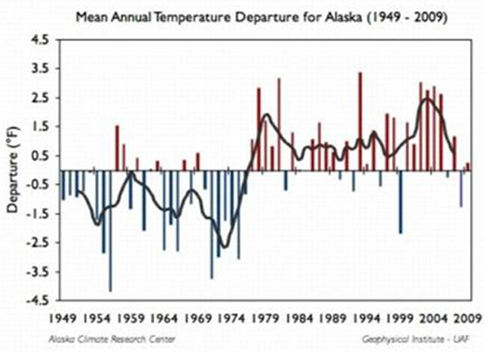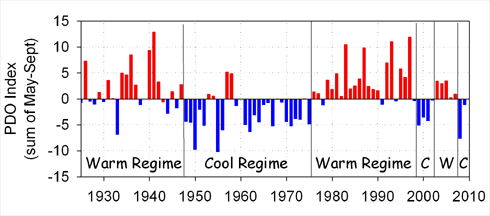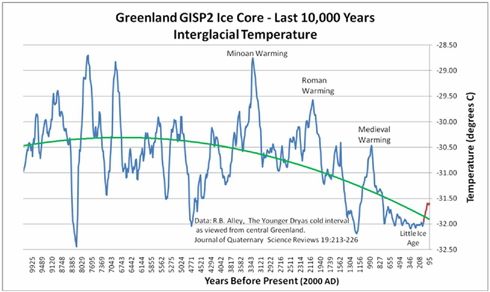Alaska Not Warming
by Ken Schlichte
A recent article in the Tacoma News Tribune quotes an ecologist from the University of Alaska Fairbanks as saying Alaska temperatures will increase by 11 degrees F by 2100 and turn interior Alaska into prairie.
Warming Could Turn Interior Into Prairie, UAF Scientist Says
AP, Tacoma News Tribune, 09/18/2010 [here]
“The projected warming of the planet could give Fairbanks the same weather as the midwestern Canadian prairies, according to a University of Alaska Fairbanks professor.
Rich Boone, an ecosystem ecologist at the College of Natural Science and Mathematics, used the climate around Saskatoon, Saskatchewan, as an example of what might be in store for Alaska’s Interior, the Fairbanks Daily News-Miner reported.
Fairbanks faces a roughly 11-degree temperature increase by 2100 if moderate climate-change models are used, Boone said during a talk Wednesday.
If that happens, the Interior no longer will be characterized by permafrost and boreal forests, he said.
“That’s very realistic,” Boone said. “We’d be in a zone that would potentially be prairie.”
Models used by the Intergovernmental Panel on Climate Change predict worldwide temperatures will increase by about 6 degrees Fahrenheit during the next century. Arctic regions have been warming at roughly twice the rate of other parts of the globe, Boone said.
Based on indicators that include ice cores, tree rings and other data, Boone said the only other known period of such rapid change was the end of the last ice age about 12,000 years ago.
Earth’s climate has been remarkably stable during the past 1,000 years, he said, allowing humans to develop reliable agriculture and the civilization that accompanies it.”
The UAF professor suggests that Fairbanks faces a roughly 11-degree temperature increase by 2100, but the Alaska Climate Research Center figure (below) and their discussion of it indicates that Alaska had a large temperature increase in 1976 due to a phase shift in the Pacific Decadal Oscillation, and since 1977 little additional warming has occurred in Alaska.

Mean Annual temperatures departure from “normal” for Alaska, 1949-2009

Pacific Decadal Oscillation Index, 1925-2010
From the Alaska Climate Research Center:
Considering just a linear trend can mask some important variability characteristics in the time series. The figure at right [1st figure above] shows clearly that this trend is non-linear: a linear trend might have been expected from the fairly steady observed increase of CO2 during this time period. The figure shows the temperature departure from the long-term mean (1949-2009) for all stations. It can be seen that there are large variations from year to year and the 5-year moving average demonstrates large increase in 1976. The period 1949 to 1975 was substantially colder than the period from 1977 to 2009, however since 1977 little additional warming has occurred in Alaska with the exception of Barrow and a few other locations. The stepwise shift appearing in the temperature data in 1976 corresponds to a phase shift of the Pacific Decadal Oscillation from a negative phase to a positive phase. Synoptic conditions with the positive phase tend to consist of increased southerly flow and warm air advection into Alaska during the winter, resulting in positive temperature anomalies.
The professor’s statement that the earth’s climate has been remarkably stable during the last 1,000 years also conflicts with the significant temperature decreases that occurred between the Medieval Warm Period and the Little Ice Age and the significant temperature increases that have occurred since the Little Ice Age.

Note: It should also be considered that prairies are not wholly the result of temperature in that they occur across a wide range of climatic zones. There are prairies in Amazonia, for instance. Prairies result from very frequent fire in low rainfall regions. And sometimes high rainfall regions. There are remnant prairies in coastal Washington, for instance, where it rains buckets (see [here]). Much study has revealed that anthropogenic (human-set) fires have driven prairie formation and maintenance worldwide during the Holocene. - Mike Dubrasich
